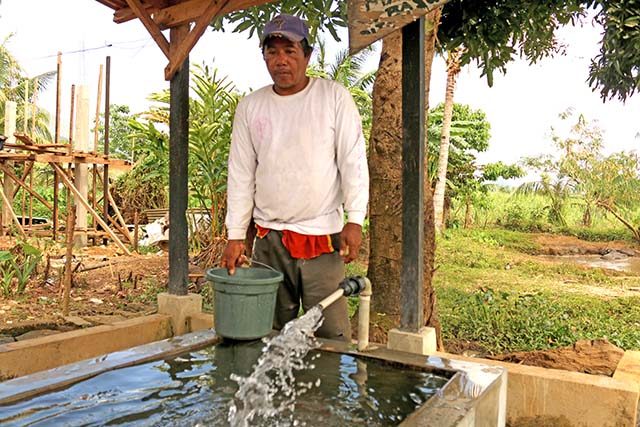SUMMARY
This is AI generated summarization, which may have errors. For context, always refer to the full article.

MANILA, Philippines – After Super Typhoon Yolanda (Haiyan) in 2013 broke the water pipes in Barangay Donghol in Ormoc, Leyte, 46-year-old Angelito Laurente had walk two kilometers to fetch water from the river.
“There were times that we were unable to cook dinner because we had no water to boil, and those nights I would need to trek to the river so my family could eat. Those were the moments when I realized how important water systems are,” Laurente said.
But it wasn’t just the walk that made access to water so difficult. Laurente related another concern. “When there was rain it was very hard because the water wasn’t clean. I worried about my 4 children’s health.”
Laurente was one of the 20 volunteers who helped dig the hole to restore the water system in his community in Barangay Donghol, Ormoc, Leyte. Their job was to lay the water pipes underground to enable easy access to clean, safe water for their village.
For many communities including Barangay Donghol, they simply didn’t have access to materials or resources to undertake necessary repairs.
“When I heard that World Vision was going to donate the materials for the broken pipes but needed volunteers to construct it, I didn’t hesitate to put my hand up. Not only did I want to help our community, but it will make my family’s life much easier.”
World Vision’s Infrastructure Manager Bernie Tudio says that this is a way to ensure that the community have buy in and involvement, empowering them to play a part in their recovery. “It also acts as a training mechanism. In the event that there is another disaster and the pipes are damaged, community members already know what needs to be done, so they will be able to facilitate the repair.”
“Every time I see the water system, I’m proud of myself and all the others who contributed to construct this system. This is our life, water is our life,” Laurente said.
The water system is now serves about 2,500 people in the community with clean and safe water. World Vision also installed water tank that can store up to 4,000 litres. Children in the community can fetch water easily, leaving them with more time to play with their friends.
Meanwhile, in Talinhugon, Dagami, Leyte, 60-year old Alejandro made a commitment to look after the 4 hand pumps that his community received.
“I know how to repair water pumps when it’s damaged through wear and tear so I told myself that looking after the pumps will be my counterpart and my way of showing gratitude to those who helped us,” he said.
When Typhoon Hagupit struck last December 2014, all 4 hand pumps not only supplied clean water to more than 500 people in his village. These also became the source of water to two nearby villages for three weeks.
“It feels good to see the enthusiasm of the people in owning their recovery. It gives us the confidence that there will be sustainability even after we leave their areas,” says Tudio.
To date, World Vision has installed more than 100 hand pumps and 20 water storage tanks across Haiyan response areas in Leyte. Water testing has been conducted to all installed systems to make sure that all are safe sources of drinking water.
To further ensure the maintenance of water systems in the villages, a training was conducted to improve community sanitation, hygiene and basic health practices, supporting families to construct latrines and communities to become recognized as having Zero Open Defecation status. – Rappler.com
Add a comment
How does this make you feel?
There are no comments yet. Add your comment to start the conversation.